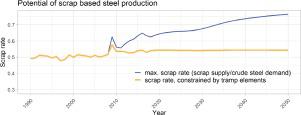Resources, Conservation and Recycling ( IF 13.2 ) Pub Date : 2021-11-21 , DOI: 10.1016/j.resconrec.2021.106072 Sabine Dworak , Helmut Rechberger , Johann Fellner

|
Global steel production has undergone massive growth since WWII. In recent decades, however, affluent regions such as the US and the EU-28 have been experiencing a saturation of the steel market. Stagnant steel production volumes and increased post-consumer scrap volumes are the consequence. The increasing shares of post-consumer scrap provide the opportunity to increase the scrap rate (share of utilized scrap) in crude steel production. However, steel recycling has a major limiting factor: the content of specific tramp elements.
In the present study, a dynamic material flow model for steel is used to compare available scrap with crude steel demand on a quantitative and qualitative level (tramp element content of Cu, Ni, Mo, Cr and Sn). The results show that post-consumer scrap increases from 80 Mt/yr (65% of all scrap available) in 2020 to more than 100 Mt/yr (75% of all scrap available) in 2050. Based on the model, the development of the yearly surplus of low purity scrap (for which there is a higher supply than demand) was assessed via material pinch analysis. The low purity scrap surplus rises further, from today's 20 Mt/yr (2020) to 43 Mt/yr in 2050. Assuming that the current handling of scrap continues, the maximal scrap rate is shown to lie at around 55%, while the potential scrap rate (without quality constraints) could reach 75%. The dilution of low purity scrap with high purity resources would allow the utilization of all scrap until 2040 if the current collection scheme remains in place.
中文翻译:

流浪元素将如何影响欧洲未来的钢铁回收?– 1910 年至 2050 年期间欧盟 28 国钢铁的动态材料流模型
自二战以来,全球钢铁产量经历了大幅增长。然而,近几十年来,美国和欧盟 28 国等富裕地区的钢铁市场已经饱和。结果是钢铁产量停滞不前,消费后废料量增加。消费后废钢份额的增加为提高粗钢生产中的废钢率(利用废钢的份额)提供了机会。然而,钢铁回收有一个主要的限制因素:特定杂质元素的含量。
在本研究中,钢的动态材料流模型用于在定量和定性水平(Cu、Ni、Mo、Cr 和 Sn 的杂质元素含量)上比较可用废钢与粗钢需求。结果表明,消费后废料从 2020 年的 80 Mt/yr(所有可用废料的 65%)增加到 2050 年的 100 Mt/yr 以上(所有可用废料的 75%)。低纯度废料(供大于求)的年度过剩是通过材料夹点分析来评估的。低纯度废钢过剩进一步增加,从今天的 20 公吨/年(2020 年)增加到 2050 年的 43 公吨/年。假设目前继续处理废钢,最大废钢率显示为 55% 左右,而潜在的废品率(无质量限制)可达 75%。



























 京公网安备 11010802027423号
京公网安备 11010802027423号